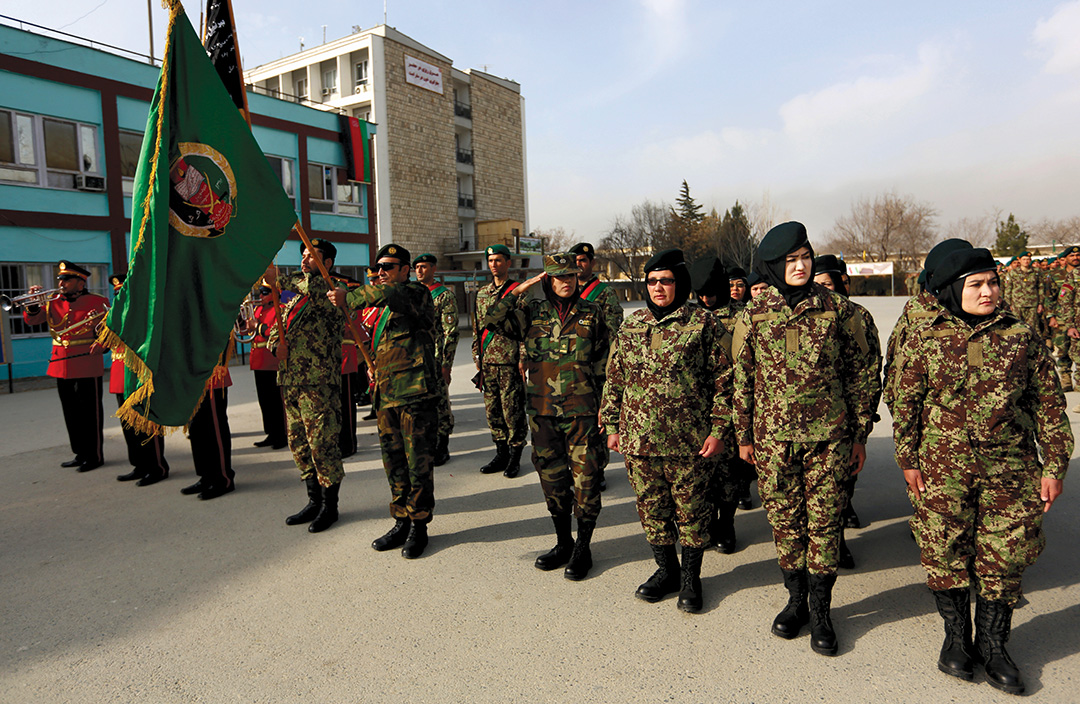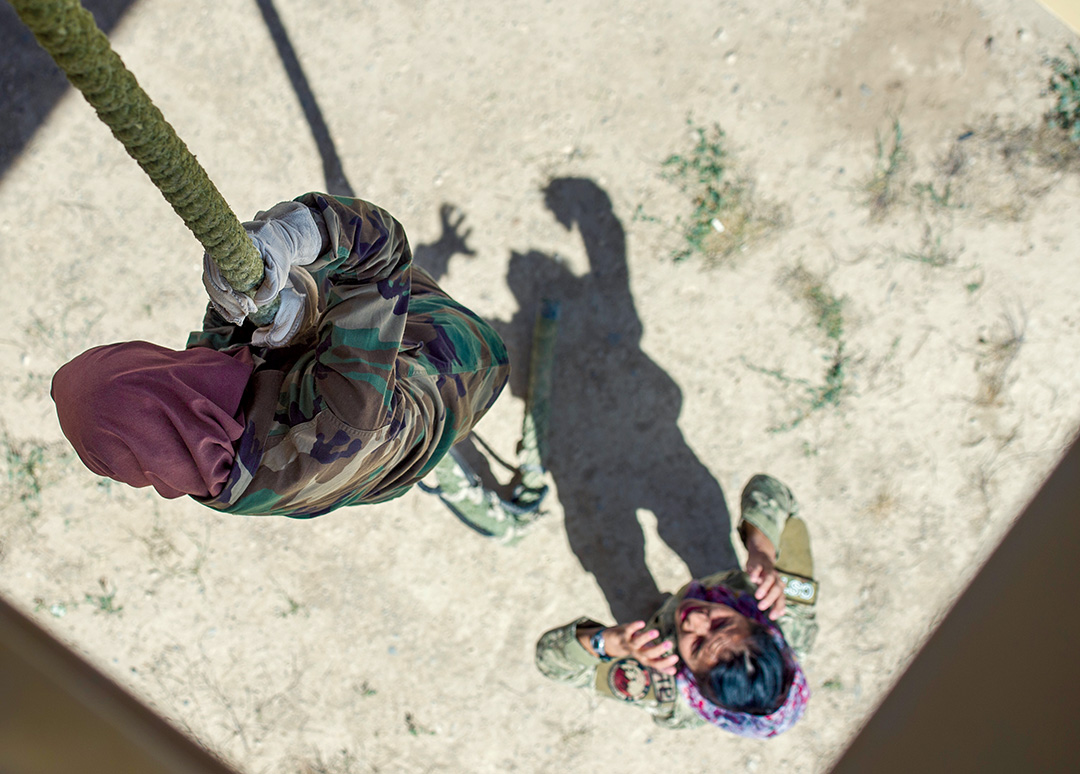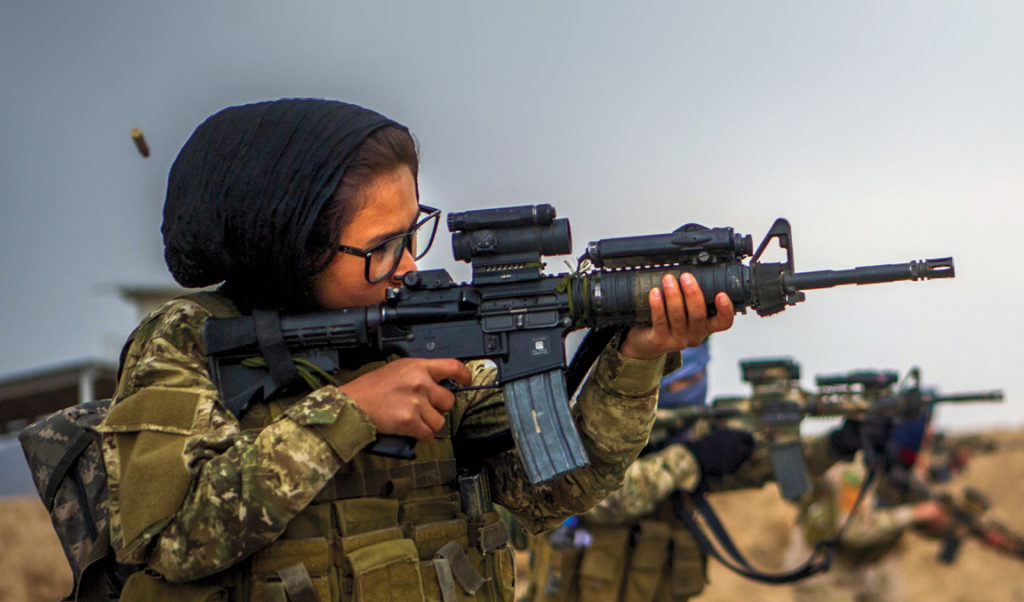More than 4,000 women are engaged in the Afghan National Defense Security Forces
MARTHA SCHAEFFER
NATO SPECIAL OPERATIONS COMPONENT COMMAND-AFGHANISTAN
When the Soviet Union withdrew from Afghanistan in 1989 and the Taliban seized control of the government, Afghan women watched as the Taliban terminated their rights overnight. A country where women were granted the right to vote in 1919, a year before the United States, and guaranteed the right to education and to work in 1964 no longer allowed women to participate as equal members of society. During restrictive male-dominated Taliban rule, they banned women from work places, schools, and from appearing in public without a male chaperone. In almost every aspect of public society, women became invisible. In the 17 years since the Taliban regime fell, the status of women has improved, although stigmas from the repressive Taliban rule remain. In 2004, the new Afghan constitution reinstated rights that women possessed previously, setting aside seats in the upper and lower parliamentary houses for women. During the 2014 elections, 308 women ran for provincial councils that have no set-aside seats; 39 percent of them won.
As women regain public roles, there is room for hope. Of the 9 million children enrolled in school in Afghanistan, 40 percent are girls. More than three quarters of the population supports women working outside the home. Women serving in the Afghan National Defense Security Forces (ANDSF), including the 120-plus women in the Afghan Special Security Forces (ASSF), have doubled their numbers in the past four years and now total 4,400, or 1.4 percent.

The Associated Press
NATO began tracking gender statistics in 2013, and five years later more than 2 percent of the Afghan National Police and 0.6 percent of the Afghan National Army are female. Afghanistan’s neighbor Pakistan, which has allowed women to serve in the military since 1947, employs only 1.4 percent in the police and 0.6 percent in the military.
While the numbers seem encouraging, they still fall well short of the ambitious 10 percent goal the Afghan Ministry of Interior, which oversees the Afghan National Police, wants to reach by 2023.
But diversifying Afghanistan’s security forces is important to Afghan stability. As retired U.S. Marine Corps Gen. John R. Allen stated in 2016: “No society has ever successfully transitioned from being a conflict-ridden society to a developing society unless women were a part of the mainstream.”
U.N. Security Council Resolution 1325 reaffirms women’s rights, and in 2015, Afghanistan released its National Action Plan (NAP), viewed as a tool to translate the resolution into reality. The NAP upholds constitutional gender equality, acknowledging “durable peace and stability in Afghanistan requires the participation of women in political and social life.” The plan also admits that though there are increased numbers of women in police, military and civil service, there are “not enough to respond to the emerging needs of women.”
NATO and the Resolute Support Mission in Afghanistan assign gender advisors to military operations. In the case of Afghanistan and special operations forces, these advisors perform their duties under the NATO Train, Advise, Assist (TAA) mission in Afghanistan, working to increase women’s representation at all levels of the ANDSF while continuously lobbying for commitment and support for female participation and retention.
One gender advisor in the NATO Special Operations Component Command-Afghanistan (NSOCC-A) expressed pride in “meeting the women serving in the ASSF and creating opportunities for them to share their ideas, experiences, concerns and needs. I call them superheroes. I really admire these women and their willingness to serve their country, despite the issues that make it more challenging for them than service in the police or military is for Western women.”
Recruiting women to security work remains a challenge — even more so recruiting for the ASSF. These are elite, special operations forces with higher requirements for admission. Promoting quality over quantity, all ASSF members, male and female, are specially selected and trained.
Women operating as part of the ASSF may be police with General Command of Police Special Units assigned to the Ministry of Interior or Soldiers serving with the Afghan National Army Special Operations Command or the Special Mission Wing.
The duties of many of the positions within ASSF require additional specialized training for sensitive missions and are harder to fill. In many cases, especially within the police forces, women’s training is continuous; the only time it’s interrupted is for operational deployments.
“My favorite part is the investigation and physical training,” said one young Afghan policewoman from Kapisa. Another woman, from Ghazni, said, “I heard about the mission and wanted to be a part of the operations. I enjoy the training and I’ve learned a lot of things. My favorite is close quarters battle.”

While the overall number of women in ASSF is small compared to the larger ANDSF, that number has doubled in just over three years. Women serve in many capacities — as medics, administrative support, finance officers and police. As numbers grow, the overall capability for meaningful participation by women in nontraditional roles grows, hand in hand with increased opportunities for career progression.
A NATO member who works the TAA mission with ASSF women in Afghanistan said, “Afghans see the value added in a highly trained Soldier. Regardless of gender, if we continue to assist in the training development and operational effects of women in the ASSF, their successes will increase interest and acceptance over time.”
Modeled on the cultural support teams employed by the U.S. Army, Afghan female tactical platoons (FTPs) are elite light infantry units that specialize in assaults on conventional targets. Trained in combat skills, marksmanship and cultural skills, the women in FTPs work alongside men during operations that may require interaction or engagement with women and children.
Additional opportunities exist for women serving with the ANDSF. Women can participate in the Ministry of Defense’s Gender Occupational Opportunity Development (GOOD) program. GOOD offers additional training in English, Dari and job skills such as computer literacy that can enhance career development. The program will soon expand to the Ministry of Interior to encompass even more of the women serving in the ASSF.
“I believe their success can be attributed to the advisor support, the best trainers and equipment, a decent work environment and additional leave opportunities and pay,” said an NSOCC-A advisor who works with the FTPs.

In many ways, the women in the ASSF aren’t just taking on the Taliban and other terrorist organizations operating in Afghanistan today, they’re also taking on their own culture. ASSF tashkils — the government’s official list of personnel by position and rank — will see a large increase in female-only positions over the next few years. But the path to real parity may not be so straightforward.
Literacy rates are low. When only 17 percent of women can read and write, the overall pool of qualified ASSF candidates shrinks significantly, although conversely, it follows that the women who are accepted will be better educated and more able to work in a wider range of duties.
Sexual harassment and gender discrimination remain a problem within the Afghan police and military. The Ministry of the Interior has a signed sexual harassment policy while the Ministry of Defense policy is in draft format, but compliance mechanisms are lacking.
Marked differences exist even in Afghan tribal cultures. Pashtuns tend to be more socially conservative; Hazara and Tajik families are more accepting of female relatives working. A number of the young women interviewed are Hazara and indicated their families were supportive of their work. One said her uncle actually encouraged her to join the ASSF.
Attractive recruitment and training initiatives are offered within Afghanistan’s military and police forces. Within the ANDSF, almost 200 women are working toward bachelor’s degrees, and several women completed their first year of college under a scholarship program. There are special incentives for day care, re-contracting bonuses, training and education allowances and opportunities for overseas training. Female-only barracks, bathrooms, gyms and classrooms are being built throughout Afghanistan to ensure women can live and train safely.
High-profile instances of women breaking barriers in the ASSF and the larger ANDSF continue to inspire other women to volunteer to serve their country. Brig. Gen. Khatool Mohammadzai, the Afghan paratrooper who has over 600 jumps to her credit and is the first woman in Afghan history to achieve general officer rank, has proven women can carve out careers in the military, both as an enlisted paratrooper and later as a commissioned officer.
As more women reap the benefits of education, enjoy meaningful careers and help to support their families, they also pave the way for their sisters, daughters and nieces to shape their own futures.

